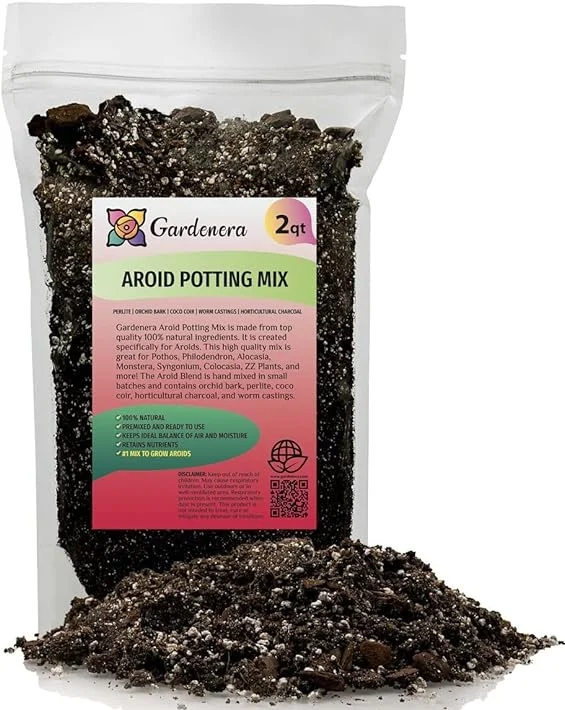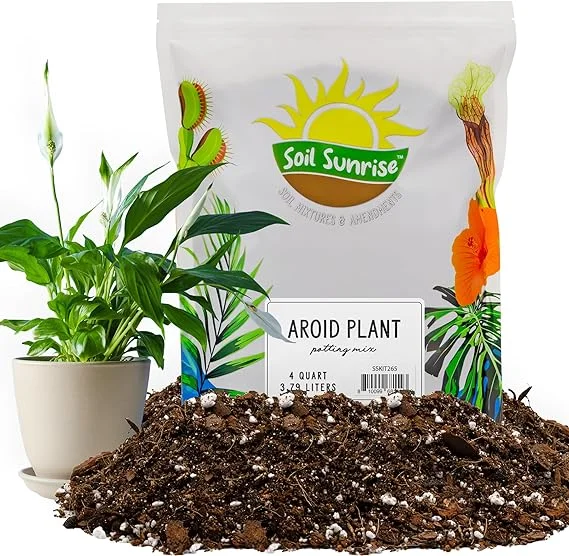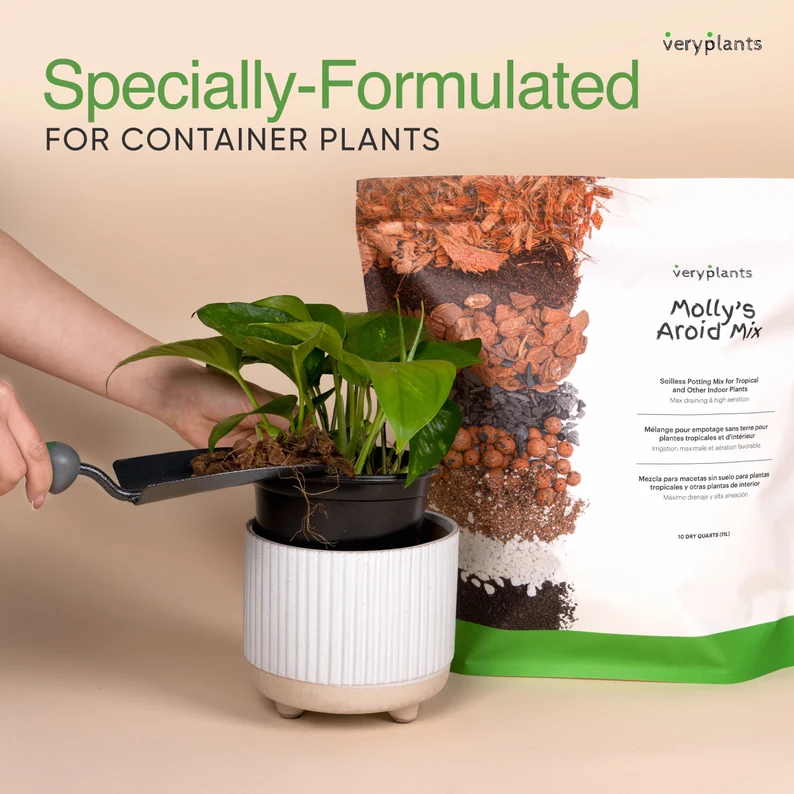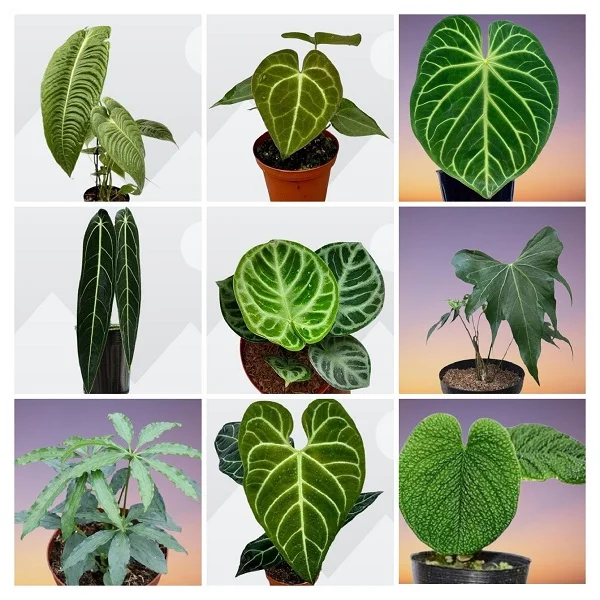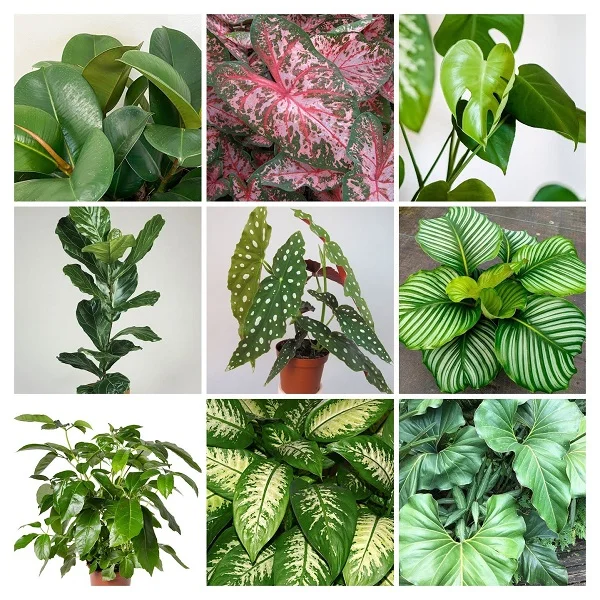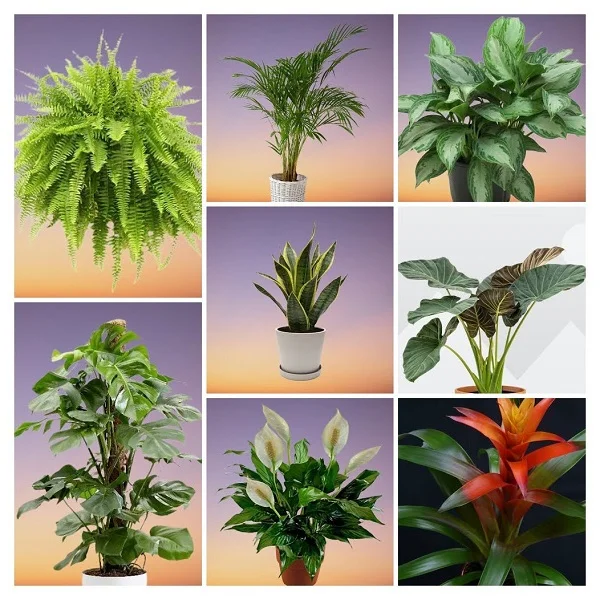Anthurium andraeanum (Laceleaf Anthurium) Care Indoors, Propgation, Problems and Remedies
Some links in this post may be affiliate links
Anthurium andraeanum (Laceleaf Anthurium) grows best in bright indirect light, average warmth, moderate humidity and consistently moist, fertile, well-drained soil coupled with fortnightly feeding during the growing season.
Laceleaf Anthurium also called Laceleaf Plant, Oilcloth Flower, Painter's Palette or Tailflower is one of the popular Anthurium varieties on account of its spectacular blooms and glossy dark-green leaves.
Painter's Palette bears long, glossy blooms with a straight or arched yellow or white tail. With proper care it can last for many years.
Tailflower is among the popular flowering plants and has gained the Royal Horticultural Society's Award of Garden Merit. The leaves and flowers are often used in flower arrangements.
Laceleaf Plant is often mistaken for Anthurium scherzerianum (Flamingo Flower) the difference between them is in the spadix where Anthurium andraeanum has a straight spadix while Anthurium scherzerianum has a curly one.
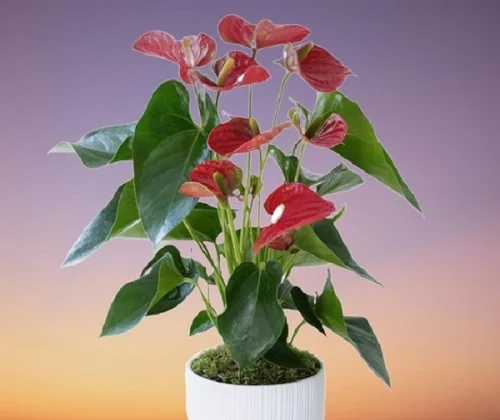
Botanical name: Anthurium andraeanum
Family: Araceae
Common names: Laceleaf Anthurium, Laceleaf Plant, Oilcloth Flower, Painter's Palette, Tailflower
Origin
Anthurium andraeanum is native to the tropical regions of Columbia and Ecuador where it grows as an epiphyte on trees but it has been naturalized in other parts of the world.
Size
Laceleaf Anthurium grows to a height of 2-3 feet and bears 4 inches long glossy blooms. The leaves are glossy, dark-green, heart-shaped and are about 9 inches long.
Flower
Painter's Palette flowers are not true flowers but are spathes, each with a yellow or white spadix covered densely with tiny true flowers.
Varieties
Anthurium andraeanum has many varieties and hybrids which are available in white, pink, orange and red flowers.
Air Purification
According to the NASA Clean Air Study, Anthurium andreanum was found to be among the best air-cleaning plants and gets rid of formaldehyde, toulene, xylene and ammonia from indoor air.
Is Anthurium andraeanum poisonous?
Anthurium andraeanum like other Anthuriums is considered toxic to both humans and pets. They contain oxalate crystals which can cause digestive distress, breathing problems and skin irritation. Keep these plants away from children and pets to avoid any mishaps. Always wear gloves when handling the plants and wash your hands thereafter.
Where to Buy
Would you like to add Laceleaf Anthuriums to your collection? You may obtain beautiful and vibrant plants online from Etsy (Link to Etsy).
How to care for Anthurium andraeanum indoors
To care for Anthurium andraeanum, provide bright indirect light (dappled light), average warmth of 18-270C, moderate humidity of 50-60% and consistently moist, rich, well-drained, aroids potting soil coupled with fortnightly feeding in the growing season.
Laceleaf Anthurium care requires pruning to keep it neat and tidy as well as minimize pest and disease infestations. Repotting is only ncessary when the plant becomes pot-bound. Keep reading for a detail account on the best growing conditions and how to achieve them.
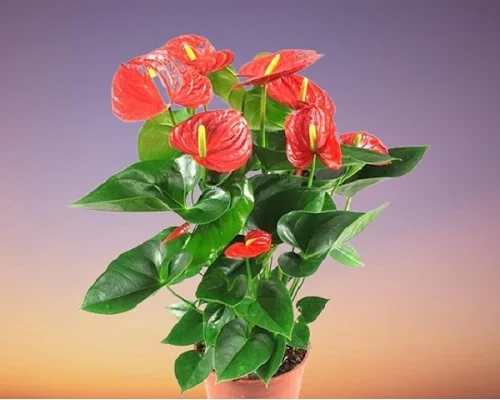
Watering
How often should I water Anthurium andraeanum?
Do not water your Anthurium andraeanum on a schedule to avoid either overwatering or underwatering both of which are detrimental to the growth of the plant.
Water your Anthurium andraeanum thoroughly in spring and summer while allowing the top 1-2 inches of soil to dry out between waterings. Keep soil moist but not soggy to prevent yellowing and rotting.
Decrease watering in fall and winter as growth is reduced to maintain the soil slightly moist. However, do not let the soil dry out completely to avoid brown, crispy leaf edges.
Use tepid water that is free of chlorine water as the plant is sensitive to chlorine and other chemicals dissolved in water. Avoid wetting the foliage as it can lead to fungal diseases.
Make sure that the pot has a drainage hole to prevent the soil from getting soggy as it may cause yellow leaves and root-rot leading to the death of the plant.
Light Requirements
Where is the best place to put Anthurium andraeanum?
Anthurium andraeanum thrives under bright indirect light. A curtain-filtered sunny window is perfect for this plant. Keep it away direct sunlight to avoid scorching; brown spots on the leaves.
If the lighting is not adequate, the plant may not flower. Therefore, use a full spectrum grow light to promote blooming and a lush growth.
Regularly rotate the pot to ensure that the plant receives light on all sides for uniform growth to prevent unbalanced growth.
Temperature and Humidity
Anthurium andraeanum requires an average warmth of 18-270C to thrive. Keep it away from drafts coming from windy doors, drafty windows, heat sources and AC units to prevent sudden drops in temperature which can cause reduced growth and drooping.
Laceleaf Anthurium flourishes in a moderate humidity of 50-60%. If the humidity is too low it may lead to brown leaf tips and edges and the plant may not bloom. To elevate humidity, set the pot on a wet pebble tray or use a cool mist humidifier.
You may also grow the plant in a well-lit bathroom, kitchen, laundry area and other moist areas in the home. Further more, you can group it with other plants to create a microclimate.
Fertilizer
What is the best fertilizer for Anthurium andraeanum?
Feed your Anthurium andraeanum with a phosphorous-rich, water-soluble fertilizer every 2-3 weeks in spring and summer to promote flowering.
Withhold feeding in fall and winter as growth is minimal and feeding at this time can lead to fertilizer burn and death of the plant.
Flush out accumulated salts in the soil every 1-2 months by running a stream of water through the soil until the water comes out through the drainage hole. Allow it to run for a few minutes and repeat the process several times.
Potting Medium
Laceleaf Anthurium prefers well-draining, airy soil that is rich in organic matter as it mimics its natural epiphytic environment. Most potting mixes designed for Aroids are ideal for this plant.
Repotting
Repot Anthurium andraeanum every 2-3 years at the beginning of the growing season (spring to early summer), when it becomes pot-bound. Be on the look out for roots growing through the drainage holes.
Use a pot one-size larger than the current one. Confirm that the pot has a drainage hole to prevent the soil from getting soggy as it can lead to root-rot. Take a look at these self watering planters with drainage hole on Amazon.
Make sure to repot in well-draining soil as the plant cannot tolerate overwet soil. Water thoroughly and avoid fertilizing for 2 weeks after repotting.
Pruning & Grooming
Pruning Anthurium andraeanum is easy. Remove yellow and dead leaves to maintain the plant neat as well as discourage pest and disease infestations.
Cut the leaves at the base of the stem with a sharp sterilized knife or with a sharp, clean pair of pruning scissors to avoid unnecessary injury which can result in disease infestation. Remove any wayward leaves to maintain the shape of the plant.
Regularly clean the leaves by damp-wiping with a soft cloth to get rid of dust as well as discourage pests and diseases infestation. Do not leave water drops on the leaves as they may lead to fungal infestations.
How to force Anthurium andraeanum to bloom
After blooming, give the Laceleaf Anthurium a 6 weeks rest period in a cool, dimly-lit room at 150C. Give it very little water during this period.
Bring out the plant after the rest period and continue with normal care. This will break the dormancy cycle and signal the plant to start blooming.
Anthurium andraeanum Propagation
Anthurium andraeanum propagation is done the beginning of the growing season (spring to early summer) from splits by plant divison.
Propagating Laceleaf Anthurium by plant division
- Thoroughly water the plant at least 1 day before to make it easier to divide and also hasten establishment.
- Slip the plant out of its pot and carefully divide it into sections by pulling apart the roots. Ensure each section has adequate roots to hasten establishment.
- Select a 6 or 8 inches pot and ensure that the pot has a drainage hole to prevent the soil from getting soggy as it can lead to rotting.
- Fill the pot with free-draining potting mix and make a hole in the center of the pot. Confirm that the hole is slightly wider than the root base of the section.
- Place the section in the previously made hole and lightly firm the soil around the base while taking care not to bury it too deep; maintain the section at the same soil level it was in the previous pot.
- Wet the soil thoroughly and place the set up in a well-lit, warm place until the new plant is well established after which you can begin routine care.
Related Content: How to Propagate Anthurium Plants by 5 Easy Methods.
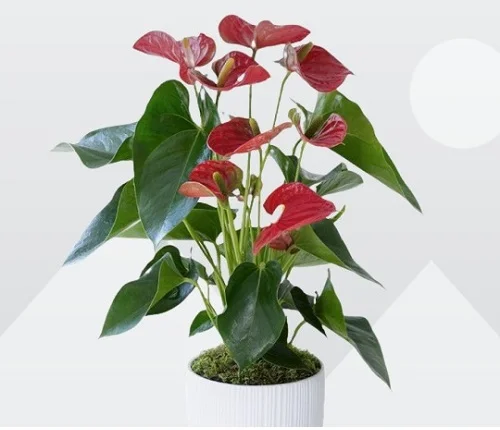
Anthurium andraeanum Problems & Solutions
Anthurium andraeanum problems are brown leaves, yellow leaves, lack of blooms, drooping leaves, brown leaf tips, brown leaf spots, pests and diseases among others. Keep reading for more on these problems, their remedies and solutions.
Brown leaves
The main causes of brown leaves on Anthurium are incorrect watering, too little light, improper feeding, poor quality soil, being pot-bound, pests, diseases, hot temperatures, age among others.
Yellow leaves
Some of the causes of yellow leaves on Anthurium andraeanum are inconsistent watering, soggy soil, drafts, and too little light.
How to fix it
Inconsistent watering: Water when the top 1-2 inches of soil dry. Do not water on a schedule.
Soggy soil: Use a pot that has a drainage hole and soil that is free-draining.
Drafts: Protect or keep the plant away from drafts coming from windy doors and windows, AC units, stoves, hot air vents among other.
Too little light: Move the plant to a brighter spot or use a grow light if the natural light is not enough.
Lack of blooms
Lack of blooms on Anthurium andraeanum is caused by too liitle light, inconsistent watering, dry air, and lack of nutrients.
How to fix it
Too little light: Position the plant in bright indirect light or instal a grow light if the natural lighting is not adequate.
Inconsistent watering: Water when the top 1-2 inches of soil dry out. Do not water on a schedule.
Dry air: Use a wet pebble tray or a humidifier to elevate humidity.
Lack of nutrients: Feed every 2 weeks in spring and summer with a phosphorous-rich, water-soluble fertilizer but do not feed in fall and winter.
Drooping leaves
Drooping leaves on Anthurium andraeanum are due to low humidity, incorrect watering, drafts, direct sunlight, and pests infestations.
How to fix it
Low humidity: To raise humidity, set the pot on a wet pebble tray or use a humidifier. You may also grow the plant a well-lit bathroom, kitchen, or laundry area.
Incorrect watering: Do not water on a schedule. Water when the top 1-2 inches of soil feel dry. Do not allow the soil to dry out completely.
Drafts: Keep the plant away from drafts originating from AC units, windy doors, drafty windows, heat sources and others.
Direct sunlight: Keep the plant away from direct sunlight or use a sheer curtain to filter the sunlight.
Pests infestations: Inspect the plant regularly for pests and take timely control measures.
Brown leaf tips
Brown leaf tips in Anthurium andraeanum are due to dry air, underwatering and soggy soil.
How to fix it
Dry air: Set the pot on a wet pebble tray, use a humidifier to increase humidity or grow the plant in a well-lit bathroom.
Underwatering: Water when the top 1-2 inches of soil dry. Do not allow the soil to dry out completely.
Soggy soil: Use a pot with a drainage hole and well-draining soil.
Brown leaf spots
Brown leaf spots on Anthurium andraeanum are sunburn marks caused by exposure to direct sunlight. Move the plant to a shaded place or use a curtain to filter the light.
Pests
Common pests on Anthurium andraeanum are spider mites, aphids and fungus gnats.
How to fix it
- Check underneath the leaves regularly for these pests and take timely control measures.
- Isolate the affected plant to prevent spread to other plants.
- Treat the infested plant with neem oil or insecticidal soap as per the manufacturer's instructions.
- Damp-wipe the leaves regularly with a soft cloth to discourage the pests.
- Keep the plant well pruned to minimize the hiding and breeding places for these pests.
Diseases
Anthurium andraeanum is prone to root-rot which is prevalent in soggy soil. The disease is characterized by yellowing and wilting of the leaves which is rapidly followed by browning and plant collapse.
How to fix it
- Carefully slip the plant out of its pot and inspect the roots.
- Trim brown-black, mushy roots and treat the healthy roots with a copper-based fungicidal solution as recommended by the manufacturer.
- Disinfect the pot with the fungicidal solution or use a fresh pot to repot the plant in fresh, well-draining soil.
- Do not water the plant immediately and keep it dry for 5-7 days before you can resume watering.
- Use a pot with a drainage hole and well-draining soil to prevent the soil from soggy.
- Cut down on watering in fall and winter as growth is minimal at this time; keep the soil slightly moist.
Related Content: 8 Common Anthurium Problems and How to Fix Them
Final Thoughts
Anthurium andraeanum is a rewarding houseplant that adds a tropical touch to any indoor space. By providing the right light, water, humidity, and nutrients, your Laceleaf Anthurium will flourish with lush green leaves and vibrant flowers. Follow these tips and enjoy a thriving, exotic plant in your home.
Frequently Asked Questions
1. How often should I water my Laceleaf Anthurium?
Do not water on a schedule. Allow the top 1-2 inches of soil to dry out before watering again.
2. Can Anthurium andraeanum bloom year-round?
Yes. With proper light, humidity, and fertilization, Anthurium andraeanum can bloom throughout the year.
3. Why are my Anthurium andraeanum leaves curling?
This is a sign of underwatering, low humidity, or pests. Increase watering and set the pot on a wet pebble tray or use a humidifier to increase humidity.
4. Do Laceleaf Anthuriums need repotting?
Yes, repot every 2-3 years or it becomes pot-bound to refresh soil to keep it thriving.
5. Are Anthurium andraeanum toxic to pets?
Yes, Anthurium andraeanum is toxic to cats and dogs if ingested. It contains oxalate crystals which can cause digestive distress, breathing problems and skin irritation. Keep them out of reach of pets.
6. Can I mist my Anthurium andraeanum?
Misting is not recommended as it increases occurence of fungal diseases. You may group the plants together, set the pot on a wet pebble tray or use a cool mist humidifier to raise humidity.
You liked it? Share on social media.
Related Content
Amazon Associates Disclosure
Homeplantsguide.com is a participant in the Amazon Services LLC Associates Program, an affiliate advertising program designed to provide a means for sites to earn advertising fees by advertising and linking to amazon.com.
